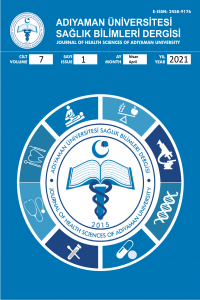İkinci ve Üçüncü Trimester Gebelerin Fiziksel Aktivite Düzeyi ve Fiziksel Aktivite Engelleri
Gebelik, fiziksel aktivite, yararları, engeller, prenatal bakım
Physical Activity Level and Barriers of Second and Third Trimester Pregnant Women
Pregnancy physical activity, exercise, benefits, barriers, prenatal care,
___
- 1. Nascimento SL, Surita FG, Godoy AC, Kasawara KT, Morais SS. Correction: Physical Activity Patterns and Factors Related to Exercise during Pregnancy: A Cross Sectional Study. PLoS One [Internet]. 15 Temmuz 2015 [kaynak 31 Ocak 2019];10(7):e0133564. Available at: https://dx.plos.org/10.1371/journal.pone.0133564
- 2. Evenson KR, Barakat R, Brown WJ, Dargent-Molina P, Haruna M, Mikkelsen EM, vd. Guidelines for Physical Activity During Pregnancy: Comparisons From Around the World. Am J Lifestyle Med. 2014;8(2):102–21.
- 3. Cioffi J, Schmied V, Dahlen H, Mills A, Thornton C, Duff M, vd. Physical activity in pregnancy: Women’s perceptions, practices, and influencing factors. J Midwifery Women’s Heal. 2010;55(5):455–61.
- 4. Prather H, Spitznagle T, Hunt D. Benefits of exercise during pregnancy. PM R [Internet]. 2012;4(11):845–50. Available at: http://dx.doi.org/10.1016/j.pmrj.2012.07.012
- 5. Daşıkan Z. Teori̇ temelli̇ bi̇reysel danışmanlık gi̇ri̇şi̇mi̇ni̇n gebeli̇kte ki̇lo yöneti̇mi̇ne etki̇si̇. Ege Üniversitesi Sağlık Bilimleri Enstitüsü, Kadın Sağlığı ve Hastalıkları Hemşireliği AD., Doktora programı, 2012, İzmir.
- 6. Downs DS, Chasan-Taber L, Evenson KR, Leiferman J, Yeo S. Physical Activity and Pregnancy. Res Q Exerc Sport [Internet]. Aralık 2012 [kaynak 31 Ocak 2019];83(4):485–502. Available at: http://www.ncbi.nlm.nih.gov/pubmed/23367811
- 7. Evenson KR, Moos M-K, Carrier K, Siega-Riz AM. Perceived Barriers to Physical Activity Among Pregnant Women. Matern Child Health J [Internet]. 14 Mayıs 2009 [kaynak 31 Ocak 2019];13(3):364–75. Available at: http://link.springer.com/10.1007/s10995-008-0359-8
- 8. Cramp AG, Bray SR. A prospective examination of exercise and barrier self-efficacy to engage in leisure-time physical activity during pregnancy. Ann Behav Med. 2009;37(3):325–34.
- 9. Hui A, Back L, Ludwig S, Gardiner P, Sevenhuysen G, Dean H, vd. Lifestyle intervention on diet and exercise reduced excessive gestational weight gain in pregnant women under a randomised controlled trial. BJOG An Int J Obstet Gynaecol. 2012;119(1):70–7.
- 10. Nascimento SL, Surita FG, Cecatti JG. Physical exercise during pregnancy: A systematic review. Curr Opin Obstet Gynecol. 2012;24(6):387–94.
- 11. Gaston A, Cramp A. Exercise during pregnancy: A review of patterns and determinants. J Sci Med Sport [Internet]. 2011;14(4):299–305. Available at: http://dx.doi.org/10.1016/j.jsams.2011.02.006
- 12. Gaston A, Vamos CA. Leisure-time physical activity patterns and correlates among pregnant women in Ontario, Canada. Matern Child Health J. 2013;17(3):477–84.
- 13. Dashti S, Joseph HL, Esfehani AJ, Su TT, Latiff LA, Esfehani RJ. Perceived barriers to physical activity among Iranian women. World Appl Sci J. 2014;32(3):422–8.
- 14. Harrison AL, Taylor NF, Shields N, Frawley HC. Attitudes, barriers and enablers to physical activity in pregnant women: a systematic review. J Physiother. 2018;64(1).
- 15. Joseph RP., Ainsworth BE., Keller C. & Dodgson JE. Barriers to Physical Activity Among African American Women: An Integrative Review of the Literature, Women & Health, 2015; 55:6, 679-699, DOI: 10.1080/03630242.2015.1039184
- 16. Godin G, Shephard JH. Leisure-time Exercise Questionnaire. MedSci Sport Exerc. 1997;29 June Su:36-38.
- 17. Sarı E, Erdoğan S. Adaptation of the Godin Leisure-Time Exercise Questionnaire into Turkish: The Validity and Reliability Study. Adv Public Heal [Internet]. 2016;2016:1– 7. Available at: http://www.hindawi.com/journals/aph/2016/3756028.
- 18. Seneviratne SN, McCowan LME, Cutfield WS, Derraik JGB, Hofman PL. Exercise in pregnancies complicated by obesity: Achieving benefits and overcoming barriers. Am J Obstet Gynecol. April 2015;442-49. http://dx.doi.org/10.1016/j.ajog.2014.06.009
- 19. Berghella V. Saccone G. Exercise in pregnancy. American Journal of Obstetrics & Gynecology, Aprıl 2017; 335-37, http://dx.doi.org/10.1016/j.ajog.2017.01.023
- 20. Mottola MF, Davenport MH, Ruchat SM, Davies GA, Poitras VJ, Gray CE, vd. 2019 Canadian guideline for physical activity throughout pregnancy. British Journal of Sports Medicine. 2018.
- 21. American College of Obstetricians and Gynecologists (ACOG). Exercise during pregnancy and the postpartum period. ACOG Committee opinion. Number 267. ACOG Committee Obstetric Practice. Obstet. Gynecol. 2002; 99(1):171-3.
- 22. Clarke PE, Gross H, Lecturer CP. Women ’ s behaviour , beliefs and information sources about physical exercise in pregnancy. Midwifery. 2004;133–41.
- 23. Wallace A, Boyer D, Dan A, Holm K. Aerobic exercise, maternal self-esteem, and physical discomforts during pregnancy. J Nurse Midwifery [Internet]. 12 Kasım 1986 [kaynak 10 Şubat 2019];31(6):255–62. Available at: https://linkinghub.elsevier.com/retrieve/pii/0091218286900340
- 24. Lynch KE, Landsbaugh JR, Whitcomb BW, Pekow P, Markenson G, Chasan-Taber L. Physical Activity of Pregnant Hispanic Women. 2012 [kaynak 10 Şubat 2019];43(4):434–439. Available at: https://www.ncbi.nlm.nih.gov/pmc/articles/PMC3491652/pdf/nihms401964.pdf
- 25. Tavares J de S, Melo AS de O, Amorim MMR de, Barros VO, Takito MY, Benício MHD, vd. Padrão de atividade física entre gestantes atendidas pela estratégia saúde da família de Campina Grande - PB. Rev Bras Epidemiol [Internet]. Mart 2009 [kaynak 10 Şubat 2019];12(1):10–9. Available at: http://www.scielo.br/scielo.php?script=sci_arttext&pid=S1415-790X2009000100002&lng=pt&tlng=pt
- 26. Duncombe D, Wertheim EH, Skouteris H, Paxton SJ, Kelly L. Factors related to exercise over the course of pregnancy including women’s beliefs about the safety of exercise during pregnancy. Midwifery [Internet]. 2009;25(4):430–8. Available at: http://dx.doi.org/10.1016/j.midw.2007.03.002
- 27. Coll CVN, Domingues MR, Gonçalves H, Bertoldi AD. Perceived barriers to leisure-time physical activity during pregnancy: A literature review of quantitative and qualitative evidence. J Sci Med Sport. 2017;20(1):17–25.
- Yayın Aralığı: Yılda 3 Sayı
- Başlangıç: 2015
- Yayıncı: ADIYAMAN ÜNİVERSİTESİ
Bruksizm Hastalarında Klinik Bulgularının Araştırılması
Günay YAPICI YAVUZ, Şeyma BAYAZIT
İkinci ve Üçüncü Trimester Gebelerin Fiziksel Aktivite Düzeyi ve Fiziksel Aktivite Engelleri
Zeynep DAŞIKAN, Özlem GÜNER, Tuğçe BOZKURT
Ameliyathane Çalışanlarında Depresyon Düzeyinin Belirlenmesi
Saliha BOZDOĞAN YEŞİLOT, Hatice ÇİFTÇİ, Tuncay SEYFİOĞLU, Tülay DOĞAN, İlknur DURNA
Görsel Medyanın Oral Cerrahi Öncesi ve Sonrası Anksiyete Üzerine Etkilerinin Değerlendirilmesi
Çocukluk dönemi tekrarlayan idiopatik epistaksiste nazofrontal açının önemi
İbrahim Hakan BUCAK, Mehmet KARATAŞ, Habip ALMIŞ, Sedat DOĞAN, Mehmet TURGUT
Diş Hekimliği Fakültesi Öğrencilerinin Dental Kaygı Seviyelerinin Karşılaştırılması
Sternotomi Ağrısında Nefes Egzersizleri Öncesi Soğuk Uygulamanın Etkisi: Yarı Deneysel Bir Çalışma
Baş ve Boyun Bölgesi Ekstrakraniyal Schwannomlarının Retrospektif Analizi ve Cerrahi Tedavisi
